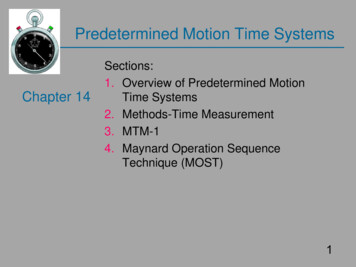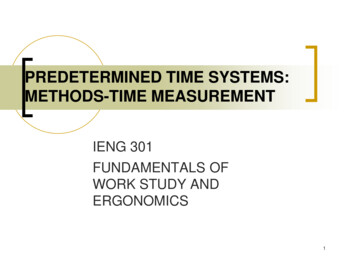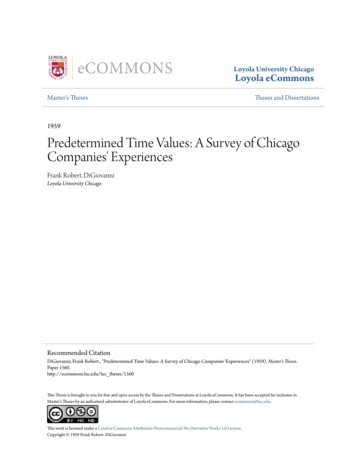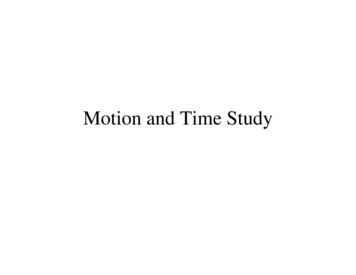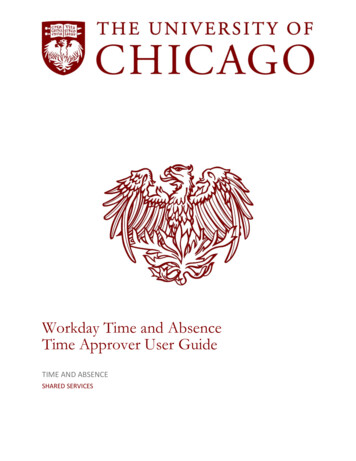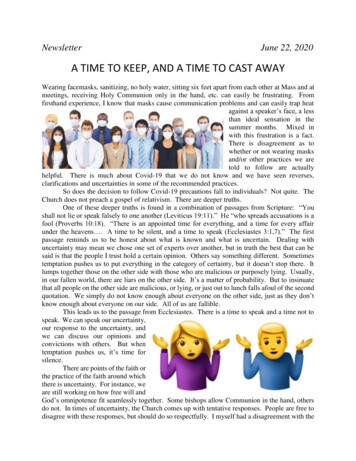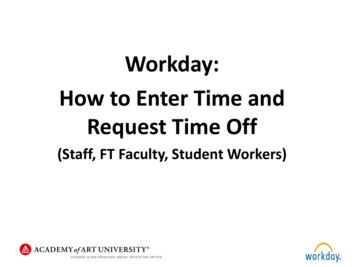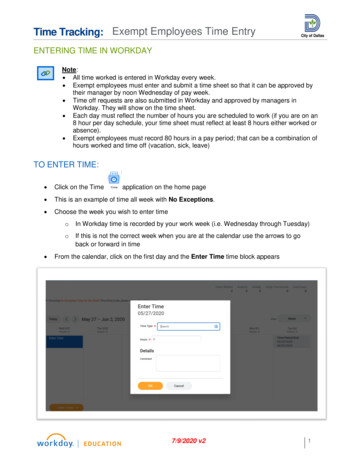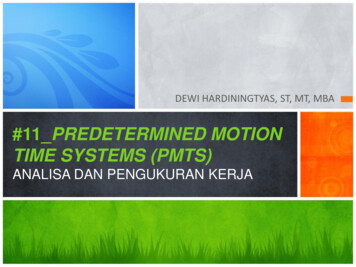
Transcription
DEWI HARDININGTYAS, ST, MT, MBA#11 PREDETERMINED MOTIONTIME SYSTEMS (PMTS)ANALISA DAN PENGUKURAN KERJA
METODE PENGUKURAN[WAKTU] KERJAPENGUKURAN [WAKTU] KERJADIRECTINDIRECTSTOP-WATCHSTANDARD DATAWORK SAMPLINGPMTS
An alternative time study that does not requireperformance rating.A database of basic motion elements and theirassociated normal time values, together withprocedures for applying the data to analyzemanual tasks and establish standard times forthe tasks.P M T Sd e f i n e d
Basic motions include:Reach Grasp Move ReleaseA set of tables that listing time values thatcorresponds to basic motion elements, thelowest level in hierarchy of manual work activity.P M T Sd e f i n e d
Historical NotesFrank B. Gilberth- 17 therbligsAsa B. Segur – Motion Time Analysis (MTA) - the firstcommercial PMT system (1922) and base on Gilberth’s 17therbligsH. Quick – Work-factor system (1934-1938): cognitive workinvolvedHarold B. Maynard – Methods-Time Measurement (MTM)(1948): very successful and widely usedG.Chris Hyde- Modular Arrangement of Predetermined TimeStandards (MODAPTS) –1966Kjell B. Zandin- Maynard Operations Sequence Technique(MOST)-(1970s)Computerization of systems as commercial products
PMTS Procedure1. Synthesize/Analyze method that would be used toperform the task–The method is described in terms of basic motion elements2. Retrieve normal time values for each motionelement–Sum the element times to determine the task normal time3. Evaluate method to make improvements by–––eliminating motionsreducing distancesusing both hands simultaneously etc.4. Apply allowances to determine standard time
PMTS LevelsandGenerations First-level PMTS use the basicmotion elements– Reach, grasp, and move usedseparately to define the task Higher-level PMTS combine severalmotion elements into motionaggregates– Reach and grasp combined intoone element called “get” First-levelsystemswerechronologically the first to bedeveloped and are called firstgeneration PMTS
ComparisonsFirst-level PMTSHigher-level PMTS Most accurate Less accurate High application speed ratio Less time to set standards Most suited to highlyrepetitive short cycles Longer cycle times feasible Basic motion elements Less detailed Very detailed Less flexible Highest flexibilitySimplified and condensed Motion aggregatesDetailedMTMMOST
METHODS TIME MEASUREMENT(MTM)
Methods-Time Measurement (MTM) Procedure which analyzes any manual operation or methodinto the basic motions required to perform it and assigns toeach motion a predetermined time standard which isdetermined by the nature of the motion and the conditionsunder which it is made. Time units are TMUs1 TMU 10-6 hr 0.0006 min 0.036 sec1 sec 27.8 TMU MTM is a family of products available through the MTMAssociation (www.mtm.org)
HIERARCHYOF WORKACTIVITYJob LevelTask LevelWork ElementLevelMTM-1Basic MotionLevel
MTM-1 Operates at the basic motion element level in our pyramidalstructure of work– Most MTM-1 basic motions involve hand and armmovements– Also includes elements for eye, leg, foot, and body actions Many of the basic motion elements correspond to the originalTherbligs developed by Frank Gilbreth More appropriate for tasks that are highly repetitive andcycle times are less than 1 min
Notasi Gerakan Notasi umum untuk setiap gerakan pada MTMadalah:abcdimana :a:gerakan dasar yang bekerjab:jarak yang ditempuhc:kelas dari gerak dasar yang bersangkutan13
Example : R10C 12.9 TMUs
Example : G1C3 10.8 TMUs
Motion Element : Move (M)Normal Time constant (factor * time in TMU) Example : M6B12 Normal Time 3.9 (1.11 * 8.9) 13.8 TMUs
Example : P3NSD 53.4 TMUs Round peg in a round hole: S(ymmetrical) Key inserted in a lock: N(on)S(ymmetrical)
Example : RL1 2 TMUsExample : D2D 11.8 TMUs
Example : T30L 8.4 TMUsExample : APB 16.2 TMUs
Other MTM Systems MTM-2 – Second-level PMTS in which basic motion elementsare combined into motion aggregates (11 motions) GET – combines Reach and GraspPUT – combines Move and PositionFor tasks that are not highly repetitive and cycle times aregreater than 1 minMTM-3 – Third-level PMTS which has four motion categoriesHandle Transport Step and foot motions Bend and arise
MTM Software (www.mtm.org)
MAYNARD OPERATION SEQUENCETECHNIQUE (MOST)
M O S T MOST is a high-level PMTS based on MTMo Same time units as MTM: TMUo Developed around 1967 under the direction ofKjell Zandino MOST is a product of H.B. Maynard and Company(an educational and consulting firm), Pittsburgh,Pennsylvania(www.hbmaynard.com)
HIERARCHYOF WORKACTIVITYJob LevelTask LevelMOSTWork ElementLevelBasic MotionLevel
Basic MOST Focused on work involving the movement of objects (e.g.,parts, tools) from one location to another in the workplace– Uses motion aggregates– Called activity sequence models Three activity sequence models:1. General move – object moved freely in space2. Controlled move – object remains in contact with asurface3. Tool use – use of hand tools (e.g., hammer, screwdriver)
Basic MOSTActivitySequence ModelGeneral MoveABG ABP ASubactivitiesA - Action DistancesB - Body MotionG - Gain ControlP - PlaceControlled MoveABG MXI AM - Move controlledX - Process timeI - AlignTool UseABG ABP * ABPA*F – Fasten*L – Loosen*C – Cut*S – Surface treat*R – Record*M - Measure
1. General Move Consists of sequence model parameters, which correspondroughly to basic motion elements Sequence model parameters for General Move:– A : Action distance (move hands or feet) – horizontal bodymotions– B : Body motion (sit, stand up) – vertical body motions– G : Gain control (closely related to grasp)– P : Placement (e.g., position, lay aside, orient)
1. General Move Standard sequence in General Move:ABGABPAgetmovereturnABG : to get an object;ABP : to move the object to a new location;A : return to original position
1 Index 10 TMU
1. General MoveDevelop the activitysequence model anddetermine the normal timefor the following workactivity:A worker walks 5 steps,picks up a small part fromthe floor, returns to hisoriginal position, andplaces the part on hisworktable.Solution :A10B6G1A10B0P1A0whereA10 walk 5 steps;B6 bend and arise;G1 gain control of small part;A10 return back;B0 no body motion;P1 lay aside part on table;A0 no motionThe sum of index values: 28.Normal time: 10*28 280 TMUs
2. Controlled Move Used when an object is moved through a path that issomehow constrained.– M : Move, controlled– X : Process time–I: Align
2. Controlled Move Standard sequence in Controlled Move:ABGMXIAgetmovereturnABG : to get an object;MXI : to move the object followed by a process timeand alignment,A : to return
2. Controlled moveDeveloptheactivitysequencemodelanddetermine the normal timefor the following workactivity:A worker takes 2 steps,grasp the waist-level feedlever on the lathe, pulls upthe lever approximately15 cm to engage the feed.Process time to turn thepart is 25 sec. Solution:25 sec.s 69.5 indicesA3B0G1M1X70I0A0whereA3 walk 2 steps;B0 no body motion;G1 gain control of lever;M1 pull the lever up 15 cm:X70 process time of ;I0 no alignment;A0 no motionThe sum of index values: 75.Normal time: 10*75 750 TMUs 27seconds
3. Tool use Applies a variety of work situations– F : fasten– L : loosen– C : cut– S : surface treat– M :measure– R : record– T : think
3. Tool use Only one is used in a sequence:ABG ABP * ABP AABG: to get the toolABP: put the tool in the position*: tool use codeABP: put the tool asideA: return
Mini MOST – for highly repetitive work cyclesperformed more than 1500 times per week Clerical MOST – similar to Basic MOST but designedfor clerical tasks MOST for Windows – Computerized technique thatallows user to apply Basic MOST, Maxi MOST, orMini MOST to the taskOther Versions of MOST Maxi MOST – for work cycles performed fewer than150 times per week and there are variations in thecycle– Can be applied to tasks of several hours
“Knowing exactly what you want to do,and then seeing that they do it the bestand cheapest way.”- Frederick W. Taylor-
Methods-Time Measurement (MTM) Procedure which analyzes any manual operation or method into the basic motions required to perform it and assigns to each motion a predetermined time standard which is determined by the nature of the motion and the conditions under which it is made. Time units are TMUs 1 TMU 10-6 hr 0.0006 min 0.036 sec
